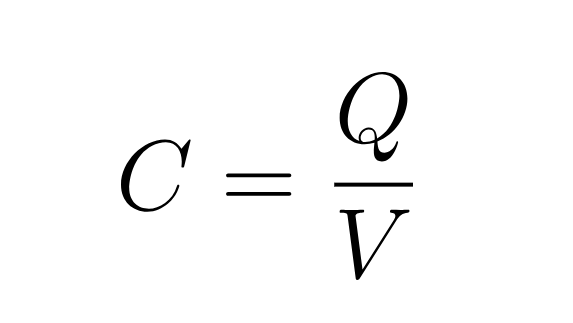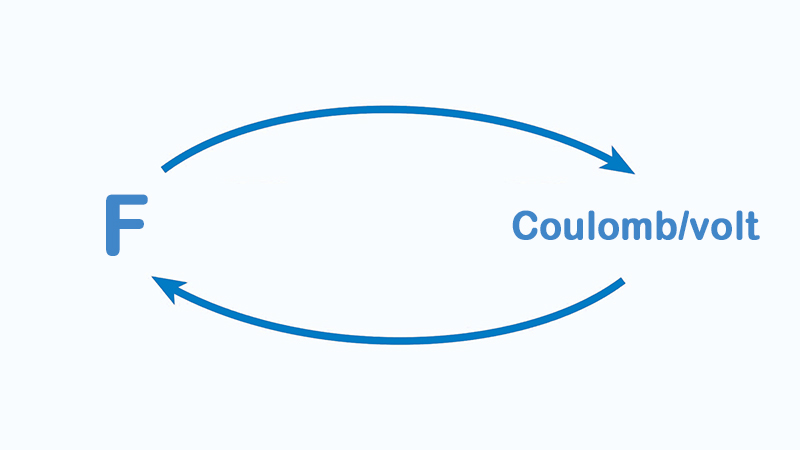The conversion from Farads to Coulombs per Volt does not require the use of any conversion calculator. Because the farad (symbol: F) is the International System of Units (SI) unit of capacitance, the ability of an object to store electric charge, equivalent to 1 coulomb per volt (C/V). This article will explain their relationship and conversion process in detail.
Capacitance value calculation formula
To calculate the capacitance value in a capacitor, you can use the basic formula derived from the relationship between charge, capacitance, and voltage:

Where:
represents the capacitance in farads (F),
is the charge in coulombs (C),
is the voltage across the capacitor in volts (V).
This formula is fundamental in understanding how capacitors function within electrical circuits. It indicates that the capacitance of a capacitor is directly proportional to the charge it holds and inversely proportional to the voltage across it.
F and Coulomb/volt definition
Farads (F) and Coulombs/Volt (C/V) are units used in the field of electronics and electrical engineering. Using the capacitance formula above, we can delve into the definitions of farads (F) and coulombs per volt (C/V):
Farad (F) definition
A farad is the unit of capacitance in the International System of Units. It is defined based on the capacitance value calculation formula. A capacitor has a capacitance of one farad when one coulomb of electric charge is stored with one volt across its plates. This unit measures the capacitor's ability to store electrical charge.
1 farad = 1 coulomb / 1 volt
Coulomb/volt (C/V) definition
The unit Coulomb/volt (C/V) is essentially another way of expressing farads, emphasizing the relationship between charge and voltage in defining capacitance. It highlights that for every volt of electric potential difference, a capacitor can hold a certain amount of charge in coulombs.
In other words, if a capacitor has a capacitance of 1 C/V, it means that it can store 1 coulomb of charge when a potential difference of 1 volt is applied across it.
Relationship between farad and coulomb
The relationship between farads and coulombs per volt is:
1 F = 1 C/V
This means that farads and coulombs per volt are equivalent units for measuring capacitance. You can directly convert between them without any additional information or calculation.
In summary, both farads and coulombs per volt describe the same property—capacitance. They are directly equivalent, with a conversion factor of 1:1, meaning 1 F = 1 C/V. This equivalence is fundamental in understanding how capacitors function within electrical circuits.
How to convert f to Coulomb/volt
To convert farads (F) to coulombs per volt (C/V), you don't need any additional information because farads and coulombs per volt are equivalent units. This is because the definition of a farad is based on the relationship between charge (in coulombs) and voltage.

1 farad (F) is defined as the capacitance of a capacitor that stores 1 coulomb (C) of charge when a potential difference of 1 volt (V) is applied across it.
Mathematically, this can be expressed as:
1 F = 1 C / 1 V
Therefore, to convert farads to coulombs per volt, you can use a simple 1:1 conversion:
1 F = 1 C/V
For example, if you have a capacitance of 0.001 farads, you can convert it to coulombs per volt as follows:
0.001 F = 0.001 C/V
Similarly, if you have a capacitance of 2,200 microfarads (μF), first convert it to farads:
2,200 μF = 2,200 × 10-6 F = 0.0022 F
Then, you can express it in coulombs per volt:
0.0022 F = 0.0022 C/V
In summary, farads and coulombs per volt are equivalent units, so you can directly convert between them without needing any additional information.
F to Coulomb/Volt Conversion Table
Capacitance (Farads, F)
| Charge per Volt (Coulombs/Volt, C/V) |
|---|
| 4.7 F | 4.7 C/V |
| 3.3 F | 3.3 C/V |
| 2.2 F | 2.2 C/V |
| 1.8 F | 1.8 C/V |
| 1.5 F | 1.5 C/V |
| 1 F | 1 C/V |
| 0.68 F | 0.68 C/V |
| 0.56 F | 0.56 C/V |
| 0.5 F | 0.5 C/V |
| 0.27 F | 0.27 C/V |
FAQ
1. What is the difference between a farad and a coulomb?
A farad (F) is a unit of electrical capacitance, which measures a capacitor's ability to store an electrical charge. A coulomb (C) is a unit of electric charge. They relate to each other through the formula Q = CV, where Q is the charge in coulombs, C is the capacitance in farads, and V is the voltage in volts.
2. How many Coulomb/volt is one farad?
One farad equals one coulomb per volt. This is derived directly from the formula Q = CV. If you have 1 farad of capacitance and you apply 1 volt across it, it will store 1 coulomb of charge.
3. Is a farad equal to a coulomb?
No, a farad is not equal to a coulomb. They are units for different physical quantities: capacitance and charge, respectively. Their relationship depends on the voltage applied across the capacitor.